|
First plant opens in Hambantota in April:
Solar power for the future
By Shirajiv SIRIMANE
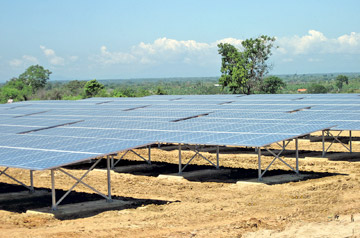 |
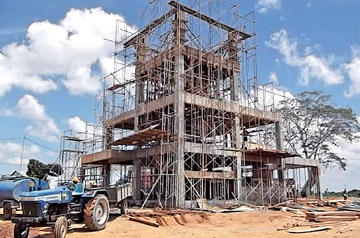
The would be control tower for the Japanese project |
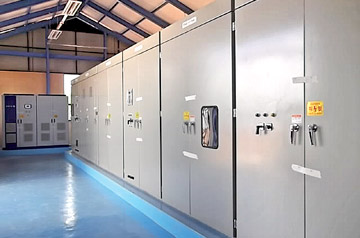
The control room |
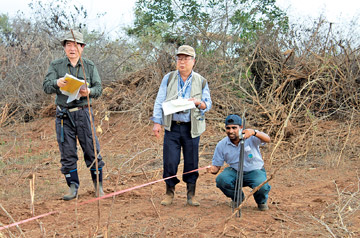
Foreign engineers at work |
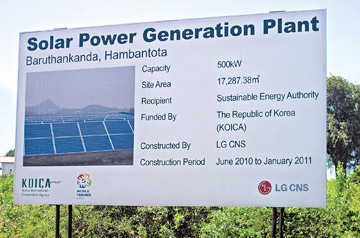 |
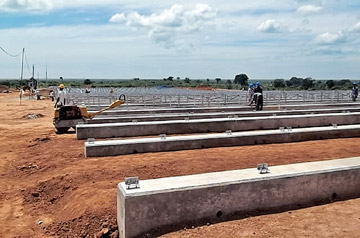
Solar panels being fitted |
|

Minister Patali Champika Ranawakaaddressing an IAEA conference
|
Gone are the days when people even in cities had to wine and dine
under candlelight due to power cuts which used to be quite common. This
had a severe impact not only on households, but also drew the economy
backwards as industries too suffered.
One of the main reasons for this situation was the lack of a vision
for the future and the then governments depending only on hydro power
and the expensive mode of generating power through diesel energy. It is
said that not a single power generation project got under way during the
past six years. Several projects were planned, but were confined to
drawing boards and foundation stones.
However, over the past five years this negative thinking pattern has
reversed and alternative power generation avenues were tapped in a bid
to ensure that there would be no power shortages in the future.
Minister of Power and Energy Patali Champika Ranawaka, himself an
electrical engineer, has taken further steps to ensure that the entire
population of the country would have electricity to their homes by the
end of next year.
This is a challenging task as the population keeps increasing and
with the end of the conflict, the Government has more areas to provide
electricity to. The Ceylon Electricity Board (CEB) had been branded as
one of the biggest loss-making institutions in the country mainly due to
mismanagement, lack of vision, heavy overheads and being burdened with
financial obligations running into millions of rupees.
The Minister who studied the CEB's future prospects decided that one
main reason for the heavy overheads was the heavy use of diesel for
power generation.
Alternative energy was the key, it was decided. Thought was even
given for nuclear energy and other sources.
One such source that was earmarked two years ago to generate
electricity was solar power.
As a result, Sri Lanka's first solar energy garden (plants) will be
opened in April in Baruthakanda, Hambantota, adding valuable energy to
the national grid.
This would be the first time that solar energy is being added
directly to the national grid on a mass scale. The solar power system
would generate power and minimise environmental pollution.
Solar power is the conversion of sunlight into electricity, either
directly using photovoltaics (PV), or indirectly using concentrated
solar power (CSP). Concentrated solar power systems use lenses or
mirrors and tracking systems to focus a large area of sunlight into a
small beam. Photovoltaics convert light into electric current using the
photoelectric effect.
CSP plant
Commercial CSP plants were first developed in the 1980s. The 354 MW
SEGS CSP installation is the largest solar power plant in the world and
is located in the Mojave Desert of California. Other large CSP plants
include the Solnova Solar Power Station (150 MW) and the Andasol solar
power station (100 MW), both in Spain. The 97 MW Sarnia Photovoltaic
Power Plant in Canada is the world's largest photovoltaic plant.
The first stage of the Hambantota project will be financed by the
Japanese Government while the Korean Government will finance its second
stage.
Japan has already provided Rs. 1,024 million for the first stage of
work under which 737 KV of power will be added to the national grid upon
completion.
Work relating to the construction of the first stage is expected to
be completed by August next year.
The second stage of the power garden which will open in April will
add 500 KV of power to the national grid. Solar panels are now fixed in
an area of over two acres in Hambantota.
The park, when completed would add 1.2 megawatts to the national
grid. The total investment on this project by both Korea and Japan is
US$ 13.4 million with the Japanese government investing US$ 8.9 million.
Grant
A unique feature of this project is that the total investment of US$
13.4 million has been awarded as a grant.
Both Korea and Japan wanted to share their solar power technology
with the world. They wanted to build two plants and hence the two
nations called for expressions of interest from developing countries.
Project Engineer, Hambantota Solar Park Suriyakumara Hettiarachchi
said that since the proposals forwarded by Sri Lanka were up to
expectations, the two grants came Sri Lanka's way. "This is a very good
achievement for a country such as Sri Lanka," he said.
Construction commenced last year and the plant built by the Koreans
in two hectares of land would be opened first, in April, adding 0.7
hours of annual electricity to the nation. "If this amount of power was
to be generated with diesel, the country would have to burn 171,841
litres of diesel! Had this process taken place it would have created 391
metric tons of carbon dioxide"
Though the initial cost of generating solar power is high, it is
considered one of the cheapest modes of generating power. Several world
renowned scientists have said that Hambantota is a hot spot for solar
power plant projects, as little rain falls in the area.
One of the other advantages of solar power is that it needs little
attention. Less than 20 people would be working in this plant. Solar
plants do not have any negative impacts on the environment.
The safety element in solar power too is good, making it an ideal
source for Sri Lanka.
There are now 15 solar energy companies operating in Sri Lanka,
creating employment for the young. Due to its immense advantages, the
private sector too is making more investments in this segment. |

